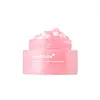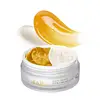What's inside
What's inside
 Key Ingredients
Key Ingredients

 Benefits
Benefits

 Concerns
Concerns

 Ingredients Side-by-side
Ingredients Side-by-side

Water
Skin ConditioningGlycerin
HumectantNiacinamide
SmoothingMethylpropanediol
SolventPropanediol
Solvent1,2-Hexanediol
Skin ConditioningDipropylene Glycol
HumectantCaprylic/Capric Triglyceride
MaskingGlycereth-26
HumectantArginine
MaskingButylene Glycol
HumectantEthylhexyl Palmitate
EmollientCetearyl Alcohol
EmollientCarbomer
Emulsion StabilisingCetearyl Olivate
Sorbitan Olivate
EmulsifyingAmmonium Acryloyldimethyltaurate/Vp Copolymer
Simethicone
EmollientEclipta Prostrata Extract
Skin ConditioningEthylhexylglycerin
Skin ConditioningAdenosine
Skin ConditioningPolyacrylate-13
Sodium Dna
Skin ConditioningDisodium EDTA
Melia Azadirachta Leaf Extract
Skin ConditioningPolyisobutene
Hydrolyzed Sclerotium Gum
HumectantGlyceryl Stearate
EmollientMoringa Oleifera Seed Oil
EmollientPolysorbate 20
EmulsifyingSorbitan Isostearate
EmulsifyingSodium Hyaluronate
HumectantGlutathione
Octyldodecanol
EmollientHydroxypropyltrimonium Hyaluronate
Salmon Egg Extract
Hydrogenated Lecithin
EmulsifyingCeramide NP
Skin ConditioningCyanocobalamin
Skin ConditioningThioctic Acid
AntioxidantHydrolyzed Hyaluronic Acid
HumectantHydrolyzed Collagen Extract
Skin ProtectingSodium Acetylated Hyaluronate
HumectantAcetyl Hexapeptide-8
HumectantCopper Tripeptide-1
Skin ConditioningHyaluronic Acid
HumectantCaprylyl Glycol
EmollientPalmitoyl Pentapeptide-4
Skin ConditioningHydrolyzed Sodium Hyaluronate
Skin ConditioningPalmitoyl Hexapeptide-12
Skin ConditioningSodium Hyaluronate Crosspolymer
HumectantPotassium Hyaluronate
Skin ConditioningWater, Glycerin, Niacinamide, Methylpropanediol, Propanediol, 1,2-Hexanediol, Dipropylene Glycol, Caprylic/Capric Triglyceride, Glycereth-26, Arginine, Butylene Glycol, Ethylhexyl Palmitate, Cetearyl Alcohol, Carbomer, Cetearyl Olivate, Sorbitan Olivate, Ammonium Acryloyldimethyltaurate/Vp Copolymer, Simethicone, Eclipta Prostrata Extract, Ethylhexylglycerin, Adenosine, Polyacrylate-13, Sodium Dna, Disodium EDTA, Melia Azadirachta Leaf Extract, Polyisobutene, Hydrolyzed Sclerotium Gum, Glyceryl Stearate, Moringa Oleifera Seed Oil, Polysorbate 20, Sorbitan Isostearate, Sodium Hyaluronate, Glutathione, Octyldodecanol, Hydroxypropyltrimonium Hyaluronate, Salmon Egg Extract, Hydrogenated Lecithin, Ceramide NP, Cyanocobalamin, Thioctic Acid, Hydrolyzed Hyaluronic Acid, Hydrolyzed Collagen Extract, Sodium Acetylated Hyaluronate, Acetyl Hexapeptide-8, Copper Tripeptide-1, Hyaluronic Acid, Caprylyl Glycol, Palmitoyl Pentapeptide-4, Hydrolyzed Sodium Hyaluronate, Palmitoyl Hexapeptide-12, Sodium Hyaluronate Crosspolymer, Potassium Hyaluronate
Water
Skin ConditioningPropanediol
Solvent1,2-Hexanediol
Skin ConditioningGlycerin
HumectantPanthenol
Skin ConditioningLaminaria Japonica Extract
Skin ProtectingEclipta Prostrata Leaf Extract
Skin ConditioningCentella Asiatica Extract
CleansingFicus Carica Fruit Extract
HumectantMelia Azadirachta Leaf Extract
Skin ConditioningMelia Azadirachta Flower Extract
Skin ConditioningCurcuma Longa Root Extract
MaskingAnthemis Nobilis Flower Extract
MaskingAnastatica Hierochuntica Extract
AstringentCalendula Officinalis Flower Extract
MaskingTuber Magnatum Extract
Skin ConditioningMalt Extract
Skin ProtectingOcimum Sanctum Leaf Extract
Skin ConditioningCorallina Officinalis Extract
Skin ConditioningHydrogenated Lecithin
EmulsifyingSodium Hyaluronate
HumectantAcrylates/C10-30 Alkyl Acrylate Crosspolymer
Emulsion StabilisingOctyldodeceth-16
EmulsifyingButylene Glycol
HumectantTromethamine
BufferingDisodium EDTA
Adenosine
Skin ConditioningFructooligosaccharides
HumectantGlyceryl Polymethacrylate
Beta-Glucan
Skin ConditioningSodium Polyacrylate
AbsorbentPvm/Ma Copolymer
Emulsion StabilisingHydrolyzed Hyaluronic Acid
HumectantCeramide NP
Skin ConditioningTocopherol
AntioxidantParfum
MaskingHydrogenated Polydecene
EmollientCaprylic/Capric Triglyceride
MaskingPhenyl Trimethicone
Skin ConditioningBetaine
HumectantPolyglyceryl-3 Methylglucose Distearate
EmulsifyingCyclohexasiloxane
EmollientCetyl Alcohol
EmollientMacadamia Integrifolia Seed Oil
Skin ConditioningPhytosteryl/Isostearyl/Cetyl/Stearyl/Behenyl Dimer Dilinoleate
Skin ConditioningGlyceryl Stearate
EmollientBehenyl Alcohol
EmollientTrehalose
HumectantPentaerythrityl Distearate
EmulsifyingCollagen Extract
Skin ConditioningNelumbo Nucifera Flower Extract
Skin ConditioningRose Extract
Skin ConditioningJasminum Officinale Extract
MaskingNarcissus Pseudo-Narcissus Flower Extract
Skin ConditioningLilium Candidum Bulb Extract
Skin ConditioningIris Versicolor Extract
EmollientFreesia Refracta Extract
Skin ConditioningAnemarrhena Asphodeloides Root Extract
Skin ConditioningOenothera Biennis Oil
EmollientGlycine Soja Oil
EmollientCamellia Japonica Seed Oil
EmollientMacadamia Ternifolia Seed Oil
EmollientHippophae Rhamnoides Fruit Oil
Skin ProtectingPersea Gratissima Oil
Skin ConditioningOlea Europaea Fruit Oil
MaskingHelianthus Annuus Seed Oil
EmollientAmmonium Acryloyldimethyltaurate/Vp Copolymer
Polyglyceryl-10 Laurate
Skin ConditioningSodium Stearoyl Glutamate
CleansingGlucose
HumectantMannose
HumectantButyrospermum Parkii Butter
Skin ConditioningHydrogenated Polyisobutene
EmollientHydroxyacetophenone
AntioxidantEthylhexylglycerin
Skin ConditioningWater, Propanediol, 1,2-Hexanediol, Glycerin, Panthenol, Laminaria Japonica Extract, Eclipta Prostrata Leaf Extract, Centella Asiatica Extract, Ficus Carica Fruit Extract, Melia Azadirachta Leaf Extract, Melia Azadirachta Flower Extract, Curcuma Longa Root Extract, Anthemis Nobilis Flower Extract, Anastatica Hierochuntica Extract, Calendula Officinalis Flower Extract, Tuber Magnatum Extract, Malt Extract, Ocimum Sanctum Leaf Extract, Corallina Officinalis Extract, Hydrogenated Lecithin, Sodium Hyaluronate, Acrylates/C10-30 Alkyl Acrylate Crosspolymer, Octyldodeceth-16, Butylene Glycol, Tromethamine, Disodium EDTA, Adenosine, Fructooligosaccharides, Glyceryl Polymethacrylate, Beta-Glucan, Sodium Polyacrylate, Pvm/Ma Copolymer, Hydrolyzed Hyaluronic Acid, Ceramide NP, Tocopherol, Parfum, Hydrogenated Polydecene, Caprylic/Capric Triglyceride, Phenyl Trimethicone, Betaine, Polyglyceryl-3 Methylglucose Distearate, Cyclohexasiloxane, Cetyl Alcohol, Macadamia Integrifolia Seed Oil, Phytosteryl/Isostearyl/Cetyl/Stearyl/Behenyl Dimer Dilinoleate, Glyceryl Stearate, Behenyl Alcohol, Trehalose, Pentaerythrityl Distearate, Collagen Extract, Nelumbo Nucifera Flower Extract, Rose Extract, Jasminum Officinale Extract, Narcissus Pseudo-Narcissus Flower Extract, Lilium Candidum Bulb Extract, Iris Versicolor Extract, Freesia Refracta Extract, Anemarrhena Asphodeloides Root Extract, Oenothera Biennis Oil, Glycine Soja Oil, Camellia Japonica Seed Oil, Macadamia Ternifolia Seed Oil, Hippophae Rhamnoides Fruit Oil, Persea Gratissima Oil, Olea Europaea Fruit Oil, Helianthus Annuus Seed Oil, Ammonium Acryloyldimethyltaurate/Vp Copolymer, Polyglyceryl-10 Laurate, Sodium Stearoyl Glutamate, Glucose, Mannose, Butyrospermum Parkii Butter, Hydrogenated Polyisobutene, Hydroxyacetophenone, Ethylhexylglycerin
 Reviews
Reviews

Ingredients Explained
These ingredients are found in both products.
Ingredients higher up in an ingredient list are typically present in a larger amount.
1,2-Hexanediol is a synthetic liquid and another multi-functional powerhouse.
It is a:
- Humectant, drawing moisture into the skin
- Emollient, helping to soften skin
- Solvent, dispersing and stabilizing formulas
- Preservative booster, enhancing the antimicrobial activity of other preservatives
Adenosine is in every living organism. It is one of four components in nucleic acids that helps store our DNA.
Adenosine has many benefits when used. These benefits include hydrating the skin, smoothing skin, and reducing wrinkles. Once applied, adenosine increases collagen production. It also helps with improving firmness and tissue repair.
Studies have found adenosine may also help with wound healing.
In skincare products, Adenosine is usually derived from yeast.
Learn more about AdenosineAmmonium Acryloyldimethyltaurate/Vp Copolymer (let's call it AAVC for short) is a synthetically created polymer. It's used as a film-forming agent and used to thicken the consistency of products.
AAVC is able to increase the consistency and viscosity of products due to its large molecule size. It also prevents ingredients from separating.
Butylene Glycol (or BG) is used within cosmetic products for a few different reasons:
Overall, Butylene Glycol is a safe and well-rounded ingredient that works well with other ingredients.
Though this ingredient works well with most skin types, some people with sensitive skin may experience a reaction such as allergic rashes, closed comedones, or itchiness.
Learn more about Butylene GlycolThis ingredient is an emollient, solvent, and texture enhancer. It is considered a skin-softener by helping the skin prevent moisture loss.
It helps thicken a product's formula and makes it easier to spread by dissolving clumping compounds.
Caprylic Triglyceride is made by combining glycerin with coconut oil, forming a clear liquid.
While there is an assumption Caprylic Triglyceride can clog pores due to it being derived from coconut oil, there is no research supporting this.
Learn more about Caprylic/Capric TriglycerideCeramide NP is a type of ceramide.
Ceramides are intercellular lipids naturally found in our skin that bonds dead skin cells together to create a barrier. They are known for their ability to hold water and thus are a great ingredient for dry skin.
Ceramides are an important building block for our skin barrier. A stronger barrier helps the skin look more firm and hydrated. By bolstering the skin ceramides act as a barrier against irritating ingredients. This can help with inflammation as well.
If you would like to eat ceramides, sweet potatoes contain a small amount.
Read more about other common types of ceramides here:
Ceramide AP
Ceramide EOP
Disodium EDTA plays a role in making products more stable by aiding other preservatives.
It is a chelating agent, meaning it neutralizes metal ions that may be found in a product.
Disodium EDTA is a salt of edetic acid and is found to be safe in cosmetic ingredients.
Learn more about Disodium EDTAEthylhexylglycerin (we can't pronounce this either) is commonly used as a preservative and skin softener. It is derived from glyceryl.
You might see Ethylhexylglycerin often paired with other preservatives such as phenoxyethanol. Ethylhexylglycerin has been found to increase the effectiveness of these other preservatives.
Glycerin is already naturally found in your skin. It helps moisturize and protect your skin.
A study from 2016 found glycerin to be more effective as a humectant than AHAs and hyaluronic acid.
As a humectant, it helps the skin stay hydrated by pulling moisture to your skin. The low molecular weight of glycerin allows it to pull moisture into the deeper layers of your skin.
Hydrated skin improves your skin barrier; Your skin barrier helps protect against irritants and bacteria.
Glycerin has also been found to have antimicrobial and antiviral properties. Due to these properties, glycerin is often used in wound and burn treatments.
In cosmetics, glycerin is usually derived from plants such as soybean or palm. However, it can also be sourced from animals, such as tallow or animal fat.
This ingredient is organic, colorless, odorless, and non-toxic.
Glycerin is the name for this ingredient in American English. British English uses Glycerol/Glycerine.
Learn more about GlycerinGlyceryl Stearate is a mix of glycerin and stearic acid.
It is used to stabilize the mixing of water and oil ingredients. By preventing these ingredients from separating, it can help elongate shelf life. It can also help thicken the product's texture.
As an emollient, it helps soften skin and supports barrier-replenishing ingredients.
In cosmetics, Glyceryl Stearate is often made from vegetable oils or synthetically produced.
This ingredient may not be fungal-acne safe
Fun fact: The human body also creates Glyceryl Stearate naturally.
Learn more about Glyceryl StearateHydrogenated Lecithin is created from the hydrogenation of lecithin (a group of phospholipids). Hydrogenation is a chemical reaction between hydrogen and another element.
This ingredient is an emollient and emulsifier. As an emollient, it helps soften skin by trapping moisture within. As an emulsifier, it prevents oil and water ingredients from separating.
Hydrolyzed Hyaluronic Acid is a form of hyaluronic acid. It is created by the hydrolysis of hyaluronic acid with a high molecular weight. Once created, Hydrolyzed Hyaluronic Acid has a low molecular weight.
Low molecular weight HA has been shown to hydrate and increase elasticity of the skin. Increasing elasticity is also associated with reduction of wrinkle depth.
One study found topical low molecular weight hyaluronic acid may be considered for the treatment of rosacea in the adult population. However, we always recommend speaking with a professional about your skin concerns.
Hyaluronic acids are a humectant. This means they draw moisture from the air. Hyaluronic acids help moisturize, soothe, and protect the skin.
Read more about other common forms of hyaluronic acid:
Learn more about Hydrolyzed Hyaluronic AcidMelia Azadirachta Leaf Extract is extract from the neem plant.
The leaves of this tree contain flavonoids and polyphenols. These two compounds are antioxidants, anti-inflammatory, and antibacterial. Further research is needed as to their effects when applied on skin.
Propanediol is an all-star ingredient. It softens, hydrates, and smooths the skin.
It’s often used to:
Propanediol is not likely to cause sensitivity and considered safe to use. It is derived from corn or petroleum with a clear color and no scent.
Learn more about PropanediolSodium Hyaluronate is hyaluronic acid's salt form. It is commonly derived from the sodium salt of hyaluronic acid.
Like hyaluronic acid, it is great at holding water and acts as a humectant. This makes it a great skin hydrating ingredient.
Sodium Hyaluronate is naturally occurring in our bodies and is mostly found in eye fluid and joints.
These are some other common types of Hyaluronic Acid:
Learn more about Sodium HyaluronateWater. It's the most common cosmetic ingredient of all. You'll usually see it at the top of ingredient lists, meaning that it makes up the largest part of the product.
So why is it so popular? Water most often acts as a solvent - this means that it helps dissolve other ingredients into the formulation.
You'll also recognize water as that liquid we all need to stay alive. If you see this, drink a glass of water. Stay hydrated!
Learn more about Water